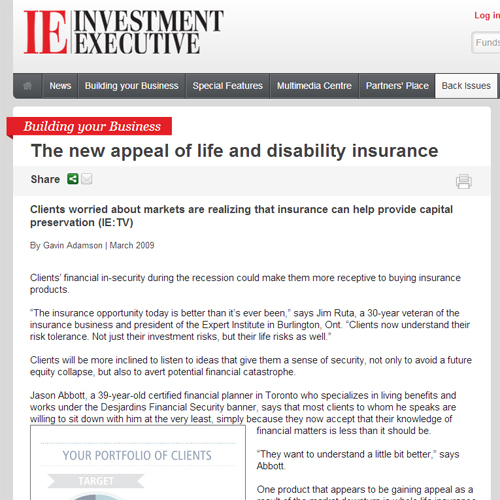
Clients worried a bout markets are realizing that insurance can help provide capital preservation
bout markets are realizing that insurance can help provide capital preservation
By Gavin Adamson
Published on March 2009
Clients’ financial in-security during the recession could make them more receptive to buying insurance products.
“The insurance opportunity today is better than it’s ever been,” says Jim Ruta, a 30-year veteran of the insurance business and president of the Expert Institute in Burlington, Ont. “Clients now understand their risk tolerance. Not just their investment risks, but their life risks as well.”
Clients will be more inclined to listen to ideas that give them a sense of security, not only to avoid a future equity collapse, but also to avert potential financial catastrophe.
Jason Abbott, a 39-year-old certified financial planner in Toronto who specializes in living benefits and works under the Desjardins Financial Security banner, says that most clients to whom he speaks are willing to sit down with him at the very least, simply because they now accept that their knowledge of financial matters is less than it should be.
“They want to understand a little bit better,” says Abbott.
One product that appears to be gaining appeal as a result of the market downturn is whole life insurance. Many clients planned on using their investment portfolios to meet their retirement needs, as well as to create an estate for their heirs. But those who took major hits in the meltdown are looking for other options. That’s not surprising, given that many clients have watched their equity portfolios shrivel by as much as 40% over the past year.
The appeal of whole life is that, in addition to the usual death benefit, there is a significant savings component that accumulates over time inside the policy. Those funds are accessible during the policyholder’s lifetime. In addition, the policies are sold at a level cost, so that premiums never change.
The hitch with the product is that, although the premium is always the same, the cost of the insurance compared with the value of the savings portion is never clear.
Still, Ruta argues, the known death benefit and guaranteed cash value (which is typically lower than the savings portion when it is held over time) look good compared with the unpredictability of equities markets. “The product eventually has a cash value on a guaranteed basis,” he says. “So, clients will never have to worry about it again.”
Another area about which clients are asking more often lately is disability insurance. The problem — as is the case with whole life and more expensive types of insurance — is how to pay for it. One avenue to consider, Abbott suggests, is to cancel any mortgage insurance the client holds and use those savings to buy other types of insurance. Should the client become ill or die, payments can be applied as the client or family wishes, rather than being automatically used to cover the mortgage.
Another way clients can secure substantial amounts of insurance during their high-income years is to obtain term insurance with a shorter term. For instance, Abbott says, a $300,000 term life insurance policy can be relatively inexpensive if the term is shortened to 10 years.
One type of disability insurance that is often overlooked by advisors, Ruta says, is a variant called “business and professional overhead insurance.” For only $70 a month, small businesses that rely on the personal participation of the owner or a principal can guarantee income if that person is unable to work as a result of illnesses included in the contract. “It kicks in after 30 days,” he says. “It pays for overhead such as car leases.”
Ruta adds that the underwriting isn’t excessive and that most clients can apply for significant coverage with just a non-medical statement of health. The cost is a business expense that can be written off. And because the benefits reimburse business expenses only, there are no tax implications.
Abbott’s belief in the importance of capital preservation has caused him to make insurance sales a priority. “I’m almost reluctant to talk about investments unless the client has proper insurance,” he says. “You can build a wonderful portfolio, but once your income disappears, it can all fall by the wayside.”
There’s another good reason to jump into insurance. Ruta says the cost of insurance may climb in the future, as insurers search for ways to deal with their investment losses and what is likely to be the rising cost of capital. He notes that Toronto-based Manulife Financial Corp. has recently issued equity and may have to issue more to meet internal actuarial capital limits and regulatory requirements. The cost of financing will eventually show up in premiums.

